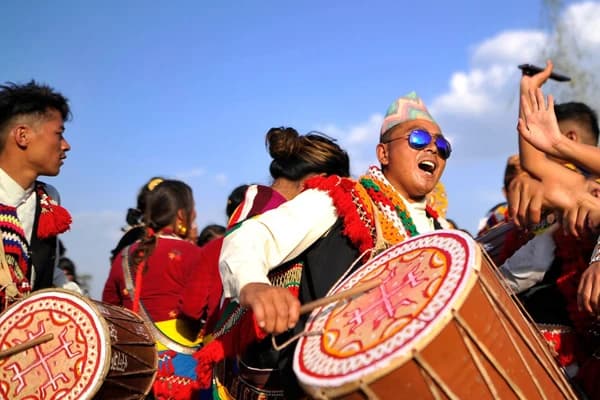Annapurna Conservation Area
Annapurna Conservation Area covers an area of 7,629 square km which makes it’s Nepal largest protected area. It lies in the lap of Mount Annapurna, the 8th-highest mountain in the world. The Annapurna Conservation Area spans over five districts Manang, Mustang, Kaski, Myagdi, and Lamjung. It ranges from the lower elevation of 790 m to the highest elevation of Annapurna I at 8,091m.
The significant altitude variation provides a diverse range of climatic conditions. Annapurna Conservation Area is famous for trekking in the Annapurna Region like annapurna base camp trek, annapurna circuit with tilicho lake trek, and so on. In 1985, it was established and is managed by the National Trust for Nature Conservation. It is a habitat of trans-mountain and Himalayan ecosystems, a variety of flora and fauna, and the origin of the deepest gorge, Kaligandaki River. The Annapurna Conservation Area has two climates in two distinguishable regions.
It experiences the highest rainfall in the southern part than in the northern region. From June to Septemeber, the region experiences the highest range of annual precipitation. During winter, the temperature ranges from -4.65 degrees Celsius to -6.06 degrees Celsius at an altitude above 4,400 m. The snow gathers with a depth of 2,000 m to 3,000 m.
It is a natural territory of 500 species of birds, and 100 species of animals, as well as several fish species, vascular plants, and indigenous flowering plants. Besides this, the Annapurna Conservation area offers holy sites like Muktinath, numerous Buddhist and Hindu pilgrimage sites, and old monasteries. You can see the highest mountain peaks like Annapurna I(8,091m), Annapurna II (7,937m), Annapurna III(7,555m), Annapurna IV(7,525m), Gangapurna (7,455m), Hiunchuli (7,441m), and Machhapuchhre (6,993m).
Facts
- Area: 7,629 sq. km.
- Population: 100,000
- Elevation: 790 m to 8,091 m
- Districts: Manang, Mustang, Kaski, Myagdi, and Lamjung
- Popular for: Annapurna Sanctuary
- Flowering Plants: 1226 species of flowering plants
- Fauna: 105 mammals, 518 birds, 40 types of Reptiles, 23 types of Amphibians
- Native mammals: Tibetan argali, snow leopard, musk deer, wolf
- Native Birds: Chukar Partridge, Pink-browed Rosefinch, Brown Fish Owl, Demoiselle Crane, and Black-faced Laughingthrush.
Manaslu Conservation Area
The Manaslu Conservation Area is located in the Mansiri Himal range of the Himalayas in the Gorkha District. In 1998, it was established and extends over an area of 1,663 square kilometers. The elevation of the Manaslu Conservation Area ranges from 1,400 m to 8,156 m. It is home to Mount Manaslu, the eighth-highest peak in the world which is located at an altitude of 8,163 m.
Besides Mt. Manaslu, it is also home to other peaks like Samdo, Larkya Peak,Simnang Himal, Langbo Kangi, Chamar, Langju, and others. The region has six climatic zones, tropical, sub-tropical, temperate, subalpine, alpine, and arctic. In summer, the average temperature ranges from 31 Degrees Celsius to 34 Degrees Celsius while it ranges from -2 Degrees Celsius to 6 Degrees Celsius in the winter season. The snowline is 5000m and far below-freezing temperatures in the Arctic zone.
From June to September, rainfall occurs with an average of 1900mm per year while the south experience higher than the upper regions. The Manaslu Conservation Area is a habitat of 33 species of mammals, 110 species of birds, 2000 species of plants, 11 types of forests, 50 species of useful plants, 11 species of butterflies, and 3 species of reptiles. The area is the natural habitat of snow leopards, Himalayan tahrs, langur monkeys, Himalayan musk deer, different birds like lammergeier, bearded vulture, and different species of frogs like Amolops Formosus, Ombrana Sikkimensis, Nanorana Liebigii, Duttaphrynus Himalayans, and more.
With the richness of Tibetan Culture at higher altitudes and Buddhism, you can explore many monasteries, prayer flags, mani walls, and authentic Himalayan life. The area offers the manaslu circuit trek that passes through challenging Larkya La pass meandering through the Budi Gandaki River valley and tsum valley trek. To conserve the rich biodiversity of the Manaslu conservation area, it is declared as a restricted area and make sure to obtain a Restricted Area Permit along with the Manaslu Conservation Area Permit while visiting.
Facts
- Area: 1,663 sq. km
- Elevation: 1,400 m to 8,156 m
- District: Gorkha
- Mammals: 33 species including the Snow leopard, Lynx, Musk deer, Red fox, Jackal, Brown bear, Blue sheep, Himalayan Tahr, Himalayan Serow, Wooly hare, and Himalayan marmot.
- Birds: 110 species, Reptiles: 3 species
- Butterflies: 11 species including the Snow partridge, Tibetan snowcock, Chukar partridge, Himalayan griffon, and Golden eagle.
- Snowline: 5,000 m
Kanchanjunga Conservation Area
The Kanchenjunga Conservation Area is located in the Taplejung District, Himalayas of Eastern Nepal. It expanded to an area of 2,035 square km and was established in 1997. The Kanchenjunga Conservation Area comprises two peaks of Kanchenjunga so it is named after Mount Kanchenjunga (8.568 m), the third-highest peak in the world.
This region also houses high mountains like Kangbachen (7,902 m), Kumbakarna (7,710 m), Gimmigela Chuli (7,350 m), and Drohmo Peak (6,881 m). The most popular glaciers in this region are Yalung Glacier (4,580 m) and Zemu Glacier. The Kanchenjunga Conservation Area is connected to the Qomolangma National Nature Preserve of Tibet in the north, and Khangchendzonga National Park of Sikkim in the east. The sacred part of the Himalayan landscape ranges from an elevation of 1,200 m to 8,586 m.
In April 2003, the Kanchenjunga Conservation Area Management Council was founded with the help of WWF and the Nepal government. It is a habitat of a wide range of fauna like Musk deer, Asian black bears, Snow Leopards, and Red Pandas, and bird species like blood pheasant, snow cock, golden-breasted Fulvetta, and red-billed chough. The spring season comes with the blooming of flowers like Lilies, orchids, and rhododendrons. In the lower zone, you can find tropical hardwoods while pine and oak trees can be found in higher altitudes.
The Nepalese Government announced this area as a gift to Earth as a part of the WWF’s Living Planet 2020 Campaign. The Kanchenjunga Conservation area comes across several trekking routes like the Kanchenjunga Circuit trek and the Kanchenjunga Base Camp trek. It is a restricted area and you must have a Restricted Area Permit along with the Kanchenjunga Conservation Area Permit for exploration.
Facts
- Area: 2035.00 Sq. Km
- District: Taplejung
- Elevation: 1200 m to 8,586 m
- Flowering Plants: 2,000 species of flowering plants approximately which contribute to 1.8% of Nepal's total floral diversity.
- Fauna: 252 species of birds, 22 species of animal, 82 species of insects, 5 species of fish, and 6 species of amphibians.
Gaurishankar Conservation Area
Gaurishankar Conservation Area covers an area of 2,179 square km. In January 2010, it was established and expanded in the Ramechhap, Dolakha, and Sindhupalchok districts and encompassed 22 Village Development Committees. It joins Tibet in the north and is connected to Langtang National Park and Sagarmatha National Parks. The Gaurishankar Conservation Area is managed by the National Trust for Nature Conservation after the Nepal government handed it for 20 years in 2010.
It has a diverse range of ecosystems from sub-tropical forests in lower regions to alpine ecosystems at higher altitudes. It is a habitat of endemic fauna like elusive red panda, musk deer, Himalayan tahr, snow leopard, and different species of pheasants. Gaurishankar Conservation Area offers the view of not only Mount Gaurishankar but other peaks like Pharchmo Peak (6,273 m), Chekigo Peak (6,257 m), Ramdung Peak (5,925 m), Pachermo Peak, and more. It is also famous for numerous trekking routes like the Rolwaling trek, Tashi Lapcha pass trek, Tso Rolpa trek, Bigu Gompa trek, Gaurishankar Foothills trek, and more.
There are a total of 16 vegetation in this region the forests of Pinus roxburghii, Schima-Castanopsis, Alnus, Pinus wallichiana, Pinus patula, Rhododendron, Quercus lanata, and Temperate Mountain oak forest. It is a habitat of 24 species of fish, 695 species of flora, 12 species of amphibians, 27 species of reptiles, 252 species of birds, and 71 species of mammals. Gaurishankar conservation area is famous for holy places like the Tsho Rolpa Lake, Dudh Kunda, and rivers like Tamakoshi, Sunkoshi, Bhotekoshi, and Khimti Khola.
Facts
- Area: 2,179 sq. km.
- Elevation: 968 m to 7181 m
- Districts: Sindhupalchok, Dolakha, and Ramechhap
- Vegetation types: 16 major vegetation like Pinus Roxburghii forest, the Schima-Castanopsis forest, the Alnus forest, the Rhododendron forest, the Pinus Wallichiana forest, the Pinus Patula forest, the Lower temperate oak forest, the Temperate mountain oak forest, the East Himalayan oak forest, the Juniper forest, the Shrubland, and the Moist alpine scrubs.
- Plant: 565 species of plants in total
- Fauna: 35 species of mammals, 16 species of fishes, 9 species of Amphibians, 22 species of Reptiles, and 235 species of Birds.
Api Nampa Conservation Area
Api Nampa Conservation Area is named after two famous peaks, Api (7,132 m) and Nampa (6,757 m). It covers an area of 1,903 square km and was established in 2010. It ranges from 518 m to 7,132 m in elevation. It is a part of the Kailash Sacred Landscape which is located in the Darchula district at the tri-junction of Nepal, India, and China. It also features the Api Nampa Base Camp trek which takes you to the base of the highest peak of Far Western Nepal.
It provides shelter to diverse wildlife like elusive snow leopards, musk deer, Himalayan black bears, and birds like the Himalayan monal, Yellow-billed chough, Red-billed chough, Snow cock,Blood pheasant, and many others. There are 8966 households and 54,358 people live in this region. The northern part is always covered in snow because of alpine climatic conditions while mid-hills have a temperate climate, while the southern section and valley side are subtropical. It is home to medicinal herbs like Yarsagumpa, Talis Patra, Kutki, Sugandhwal, Jatamansi, Panchaule, and many others.
Facts
- Headquarters: Khalanga, Darchula in the Far Western Development Region
- Adjacent Districts: Sindhupalchok, Dolakha, and Ramechhap
- Area: 1903 sq km
- Elevation: 539 m to 7132 m
- Flora: 69 species of Pteridophytes, 12 species of gymnosperms, and 535 species of angiosperms in the plant kingdom.
- Mammals: 43 different species of mammals exist, including the red panda, snow leopard, Himalayan black bear, Himalayan tahr, Himalayan musk deer, goral, and serow.
- Birds: 263 bird species, including the Himalayan Monal, the Snowcock, and the Blood pheasant,
- Fishes: 69 species
- Butterflies: 30 species
Blackbuck Conservation Area
Blackbuck Conservation Area is widely known as Krishnasaar Conservation Area. It is located in the Gulariya, Bardiya District, Nepal. It was established for the conservation of endangered blackbuck in 2009. It covers an area of 16.95 square km and the Government of Nepal obtained private land for blackbuck conservation between 1995 to 1997.
Due to its smallest area, it is the smallest conservation area of Nepal It lies in the ecosystem of the Terai region and protects forest and grasslands along with the blackbuck. In 1975, blackbuck was on the verge of extinction, and then a tiny herd of nine blackbuck were discovered in Bardiya district. Then, the Nepal Government declared Gulariya of Bardiya district as a Blackbuck Conservation Area.
As of now, there are 293 black bucks in Nepal. Blackbuck Conservation Area is the home of 281 blackbuck species, 64 bird species, 14 mammals, and 12 reptiles. Due to its diverse biodiversity, it is the perfect destination for cinematography and photography.
Facts:
- Area: 15.95 Sq. Km
- Elevation: 152 meters
- District: Bardia
- Flowering plants: Rhododendron, Larix Himalaica, Schima Wallichii, Castanopsis Indica, Picea Smithiana
- Animal protected: Endangered Blackbuck (Krishnasar), 14 species of mammals, 64 bird species, and 12 reptiles.
- Birds: 110 species
Final words
Conservation Areas seek to protect ecological diversity and advance tourism like that of National Parks. A Conservation Areas is established to conserve certain species of flora and fauna along with long-term sustainable development of the area. However, the national park of nepal protects the entire ecosystem, geographical region, and flora and fauna of that area.





